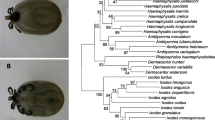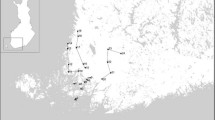Abstract
Anaplasma phagocytophilum is zoonotic gram-negative intracellular bacterium, which invades neutrophiles and causes febrile diseases. This bacterium is transmitted mainly by Ixodes ricinus in Europe. Due to lack of knowledge about prevalence of A. phagocytophilum in different tick species, our study was focused on hard ticks in the South Moravia. There are three hard tick species common in this region — I. ricinus, Dermacentor reticulatus and Haemaphysalis concinna. We collected 823 I. ricinus, 500 D. reticulatus and 37 H. concinna by flagging during 2009–2011 from 43 localities. We confirmed the presence of DNA of A. phagocytophilum in 3.8% I. ricinus (n = 31), 3.6% D. reticulatus (n = 18) and 29.7% H. concinna (n = 11) by nested PCR. All amplicons were 100% identical with sequences of A. phagocytophilum deposited in the GenBank database (accession numbers KX180948, KY11936 and KP245905, respectively). Despite the absence of clinical cases in the Czech Republic, human granulocytic anaplasmosis should be considered in patients with non-specific clinical manifestation and history of tick bite.
Similar content being viewed by others
Abbreviations
- HGA:
-
human granulocytic anaplasmosis
References
Altschul S.F., Gish W., Miller W., Myers E.W. & Lipman D.J. 1990. Basic local alignment search tool. J. Mol. Biol. 215: 403–410.
Benson D.A., Clark K., Karsch-Mizrachi I., Lipman D.J., Ostell J. & Sayers E.W. 2015. GenBank. Nucleic Acids Res. 43: D30–D35.
Blanarova L., Stanko M., Carpi G., Miklisova D., Vichova B., Mosansky L., Bona M. & Derdakova M. 2014. Distinct Anaplasma phagocytophilum genotypes associated with Ixodes trianguliceps ticks and rodents in Central Europe. Ticks Tick Borne Dis. 5: 928–938.
Blanco J.R. & Oteo J.A. 2002. Human granulocytic ehrlichiosis in Europe. Clin. Microbiol. Infect. 8: 763–772.
Boozer A.L. & Macintire D.K. 2003. Canine babesiosis. Vet. Clin. North Am. Small Anim. Pract. 33: 885–904, viii.
Derdakova M., Stefancikova A., Spitalska E., Taragelova V., Kostalova T., Hrklova G., Kybicova K., Schanilec P., Majlathova V., Varady M. & Petko B. 2011. Emergence and genetic variability of Anaplasma species in small ruminants and ticks from Central Europe. Vet. Microbiol. 153: 293–298.
Földvári G., Rigó K. & Lakos A. 2013. Transmission of Rickettsia slovaca and Rickettsia raoultii by male Dermacentor marginatus and Dermacentor reticulatus ticks to humans. Diagn. Microbiol. Infect. Dis. 76: 387–389.
Földvári G., Široký, P., Szekeres S., Majoros G. & Sprong H. 2016. Dermacentor reticulatus: a vector on the rise. Parasit. Vectors 9: 314.
Glatz M., Müllegger R.R., Maurer F., Fingerle V., Achermann Y., Wilske B. & Bloemberg G.V. 2014. Detection of Candidatus Neoehrlichia mikurensis, Borrelia burgdorferi sensu lato genospecies and Anaplasma phagocytophilum in a tick population from Austria. Ticks Tick Borne Dis. 5: 139–144.
Guy E.C. & Stanek G. 1991. Detection of Borrelia burgdorferi in patients with Lyme disease by the polymerase chain reaction. J. Clin. Pathol. 44: 610–611.
Heyman P., Cochez C., Hofhuis A., van der Giessen J., Sprong H., Porter S.R., Losson B., Saegerman C., Donoso-Mantke O., Niedrig M. & Papa A. 2010. A clear and present danger: tick-borne diseases in Europe. Expert Rev. Anti Infect. Ther. 8: 33–50.
Jahfari S., Coipan E.C., Fonville M., van Leeuwen A.D., Hengeveld P., Heylen D., Heyman P., van Maanen C., Butler C.M., Földvári G., Szekeres S., van Duijvendijk G., Tack W., Rijks J.M., van der Giessen J., Takken W., van Wieren S.E., Takumi K. & Sprong H. 2014. Circulation of four Anaplasma phagocytophilum ecotypes in Europe. Parasit. Vectors 7: 365.
Kocianova E., Kostanova Z., Stefanidesova K., Spitalska E., Boldis V., Huckova D. & Stanek G. 2008. Serologic evidence of Anaplasma phagocytophilum infections in patients with a history of tick bite in central Slovakia. Wien. Klin. Wochenschr. 120: 427–431.
Kubelová M., Tkadlec E., Bednář M., Roubalová E. & Široký P. 2011. West-to-east differences of Babesia canis canis prevalence in Dermacentor reticulatus ticks in Slovakia. Vet. Parasitol. 180: 191–196.
Kybicová K., Schánilec P., Hulínská D., Uherková L., Kurzová Z. & Spejchalová S. 2009. Detection of Anaplasma phagocytophilum and Borrelia burgdorferi sensu lato in dogs in the Czech Republic. Vector Borne Zoonotic Dis. 9: 655–661.
Majláthová V., Majláth I., Víchová B., Gulová I., Derdáková M., Sesztáková E. & Petko B., 2011. Polymerase chain reaction confirmation of Babesia canis canis and Anaplasma phagocytophilum in dogs suspected of babesiosis in Slovakia. Vector Borne Zoonotic Dis. 11: 1447–1451.
Massung R.F., Slater K., Owens J.H., Nicholson W.L., Mather T.N., Solberg V.B. & Olson J.G. 1998. Nested PCR assay for detection of granulocytic ehrlichiae. J. Clin. Microbiol. 36: 1090–1095.
Mehlhorn H., Mehlhorn T., Müller M., Vogt M. & Rissland J. 2016. Tick survey for prevalent pathogens in peri-urban recreation sites in Saarland and Rhineland-Palatinate (Germany). Parasitol. Res. 115: 1167–1172.
Mierzejewska E.J., Welc-Faleciak R., Karbowiak G., Kowalec M., Behnke J.M. & Bajer A. 2015. Dominance of Dermacentor reticulatus over Ixodes ricinus (Ixodidae) on livestock, companion animals and wild ruminants in eastern and central Poland. Exp. Appl. Acarol. 66: 83–101.
Nosek J. 1971. The ecology, bionomics and behaviour of Haemaphysalis (Haemaphysalis) concinna tick. Z. Parasitenkd. 36: 233–241.
Nosek J. & Sixl W. 1972. Central-European ticks (Ixodidae). Key for determination. Mitt. Abteil. Zool. Landesmus. Joanneum 1: 61–92.
Petrovec M., Furlan S.L., Zupanc T.A., Strle F., Brouqui P., Roux V. & Dumler J.S. 1997. Human disease in Europe caused by a granulocytic Ehrlichia species. J. Clin. Microbiol. 35: 1556–1559.
Praskova I., Bezdekova B., Zeman P. & Jahn P. 2011. Seropreva-lence of Anaplasma phagocytophilum in horses in the Czech Republic. Ticks Tick Borne Dis. 2: 111–115.
Rubel F., Brugger K., Pfeffer M., Chitimia-Dobler L., Didyk Y.M., Leverenz S., Dautel H. & Kahl O. 2016. Geographical distribution of Dermacentor marginatus and Dermacentor reticulatus in Europe. Ticks Tick Borne Dis. 7: 224–233.
Schwarz A., Maier W.A., Kistemann T. & Kampen H. 2009. Analysis of the distribution of the tick Ixodes ricinus L. (Acari: Ixodidae) in a nature reserve of western Germany using Geographic Information Systems. Int. J. Hyg. Environ. Health 212: 87–96.
Široký P., Kubelová M., Bednář M., Modrý D., Hubálek Z. & Tkadlec E. 2011. The distribution and spreading pattern of Dermacentor reticulatus over its threshold area in the Czech Republic–How much is range of this vector expanding. Vet. Parasitol. 183: 130–135.
Skotarczak B., Rymaszewska A., Wodecka B., Sawczuk M., Adamska M. & Maciejewska A. 2006. PCR detection of granulocytic Anaplasma and Babesia in Ixodes ricinus ticks and birds in west-central Poland. Ann. Agric. Environ. Med. 13: 21–23.
Sonenshine D.E. (Ed.). 1993. Biology of Ticks, Vol. 2. Oxford University Press, New York, USA, 465 pp.
Stuen S., Granquist E.G. & Silaghi C. 2013. Anaplasma phagocytophilum–a widespread multi-host pathogen with highly adaptive strategies. Front. Cell. Infect. Microbiol. 3: 31.
Tamura K., Stecher G., Peterson D., Filipski A. & Kumar S. 2013. MEGA6: Molecular Evolutionary Genetics Analysis Version 6.0. Mol. Biol. Evol. 30: 2725–2729.
Venclikova K., Mendel J., Betasova L., Blazejova H., Jedlickova P., Strakova P., Hubalek Z. & Rudolf I. 2016. Neglected tick-borne pathogens in the Czech Republic, 2011–2014. Ticks Tick Borne Dis. 7: 107–112.
Zeman P. & Pecha M. 2008. Segregation of genetic variants of Anaplasma phagocytophilum circulating among wild ruminants within a Bohemian forest (Czech Republic). Int. J. Med. Microbiol. 298: 203–210.
Zivkovic Z., Nijhof A.M., Fuente J. de la, Kocan K.M. & Jongejan F. 2007. Experimental transmission of Anaplasma marginale by male Dermacentor reticulatus. BMC Vet. Res. 3: 32.
Author information
Authors and Affiliations
Corresponding author
Rights and permissions
About this article
Cite this article
Rybářová, M., Široký, P. Occurrence of Anaplasma phagocytophilum in three sympatric tick species in the South Moravia, Czech Republic. Biologia 72, 365–369 (2017). https://doi.org/10.1515/biolog-2017-0051
Received:
Accepted:
Published:
Issue Date:
DOI: https://doi.org/10.1515/biolog-2017-0051




